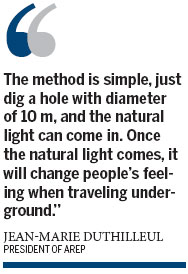Photo
French firm helps China plan harmonious urban landscape
By Han Tianyang (China Daily)
Updated: 2010-04-30 08:07
 |
Large Medium Small |
According to data provided by AREP, China's urban inhabitants increased from 77 million in 1953 to 190 million in 1980, and had surged to 470 million by 2000.
Today the figure stands at a staggering 650 million, about 45 percent of the nation's total population. The proportion is forecast to grow to 60 percent in the next decade.
The speed of urbanization is just as impressive as the population. Over 246 new towns have been built since 1990 and another 400 are scheduled to emerge by 2020.
"China is in a period of rapid growth, to which urban planning and architectural design brings the physical form and image," Duthilleul said.
In the eyes of Duthilleul, travel facilities play a crucial role in people's lives since how people move through and experience public space is just as important as how they live and work.
Planning of transportation hubs in modern cities should reflect "the dialectic of mobility and immobility", he said, giving an example of the South Shanghai Railway Station, which combines both elements.
By mobility he meant the surrounding environment where people and automobiles are moving; while the station building with impressive image and complete function brings peace and quiet in the heart of the fast-paced city.
Duthilleul also noted that all kinds of forms of moving like walking, driving, and taking buses, or taxis should be considered when designing a transportation hub, adding that it's a lesson that AREP has learnt from past mistakes in France decades ago where railway stations only connect railways.
"A transportation hub between two cities should connect not only track traffic but all kinds of vehicles," he said.

"When we designed the South Shanghai Railway Station, though it is a project under the Ministry of Railways, we thought about railways as well as other transportation forms."
The office buildings in Shanghai are often confined and isolated from the natural environment, which is contradictory to the traditional Chinese idea of harmony between man and nature, said the enthusiast of Chinese philosophy.
When asked about why he came to do architectural design in China, Duthilleul said that China and France are both countries with long histories and rich culture, which should be inherited and embodied in the modern architecture. "I am very passionate about the subject," he said, adding: "it's another dialectic that should concern city planners."







